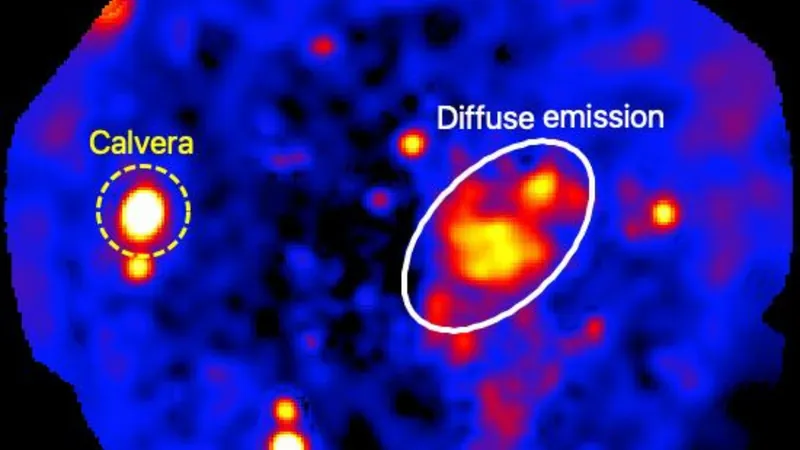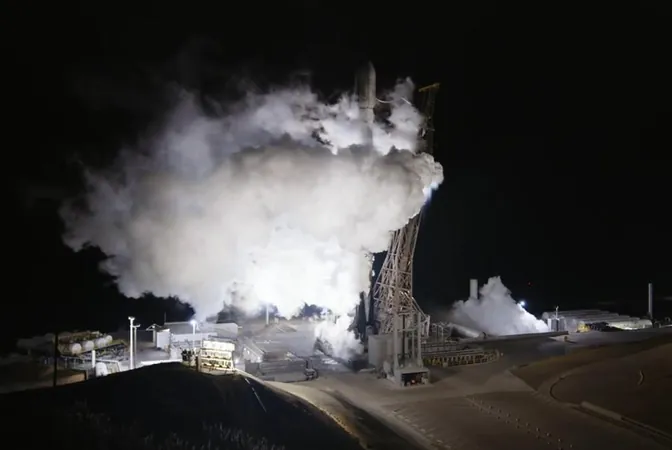
Mystery of 'Forbidden' Pulsar Uncovered: A Runaway Star Flees its Supernova in a Galactic Oddity
2025-09-02
Author: Jacques
Astronomers have made an astonishing discovery: a rogue pulsar escaping the aftermath of a colossal supernova explosion in an area of the Milky Way where such phenomena should be virtually nonexistent.
Nicknamed "Calvera"—a nod to the notorious villain from the classic film "The Magnificent Seven"—this pulsar is located about 6,500 light-years above the bustling plane of our galaxy. This empty expanse of space is typically devoid of the massive stars necessary for supernova events and neutron star formations like pulsars.
The discovery of Calvera challenges our understanding of stellar evolution and suggests we need to rethink how massive stars are formed in the Milky Way's outer regions.
A Stellar Anomaly in Space
Emanuele Greco, the lead researcher from the Istituto Nazionale di Astrofisica (INAF), stated, "Massive stars—at least eight times more massive than our Sun—almost exclusively form in the galactic plane, where gas density is highest. Finding their remnants in such desolate areas is extraordinary. Our research has allowed us to estimate the distance, age, and characteristics of the progenitor star that birthed both the Calvera pulsar and its supernova remnants."
The Explosive Tale of Calvera
The fascination with Calvera began in 2022 when astronomers detected it using the Low-Frequency Array (LOFAR) radio telescope—a unique collaboration spanning eight European countries. Initially identified as a circular structure, Calvera was recognized as remnants of a supernova in a region where such explosions are typically confined to dense star-filled areas.
Pulsars are essentially neutron stars formed when massive stars implode at the ends of their lives. Some can spin at incredible speeds, sometimes up to 700 rotations per second. The pulsar known as Calvera was previously noted for its intense X-ray emissions.
By examining Calvera's trajectory, scientists discovered that the pulsar is accelerating away from the supernova's center. This connection indicates that this runaway star is linked to an ancient explosive event from a massive star thousands of years ago.
Unraveling Cosmic History
To gain deeper insights into the Calvera system, researchers analyzed X-ray data from the European Space Agency's XMM-Newton spacecraft, along with data from other telescopes monitoring various electromagnetic wavelengths. This comprehensive analysis clarified the age of the supernova explosion, pinpointing it between 10,000 and 20,000 years ago, while placing Calvera at a distance ranging from 13,000 to 16,500 light-years.
This information reinforces the link between Calvera and its explosive origins.
A Revelation in Stellar Astronomy
The research introduces compelling insights into how supernova phenomena operate even in low-density regions, differing from the dense environments where gamma-ray emissions are usually formed. Greco highlights that previous beliefs about the operational mechanisms behind supernova emissions are evolving.
Using space telescopes like XMM-Newton and Fermi/LAT, combined with ground-based telescopes, scientists have illustrated that explosive events can occur in seemingly empty regions of space, producing extraordinarily high-temperature plasma.
Greco concluded, "Our study shows that even the quietest and emptiest parts of the galaxy can host dramatic cosmic processes. The precise characteristics we’ve identified for the Calvera system encourage us to explore the fringes of the Milky Way with new curiosity."









 Brasil (PT)
Brasil (PT)
 Canada (EN)
Canada (EN)
 Chile (ES)
Chile (ES)
 Česko (CS)
Česko (CS)
 대한민국 (KO)
대한민국 (KO)
 España (ES)
España (ES)
 France (FR)
France (FR)
 Hong Kong (EN)
Hong Kong (EN)
 Italia (IT)
Italia (IT)
 日本 (JA)
日本 (JA)
 Magyarország (HU)
Magyarország (HU)
 Norge (NO)
Norge (NO)
 Polska (PL)
Polska (PL)
 Schweiz (DE)
Schweiz (DE)
 Singapore (EN)
Singapore (EN)
 Sverige (SV)
Sverige (SV)
 Suomi (FI)
Suomi (FI)
 Türkiye (TR)
Türkiye (TR)
 الإمارات العربية المتحدة (AR)
الإمارات العربية المتحدة (AR)